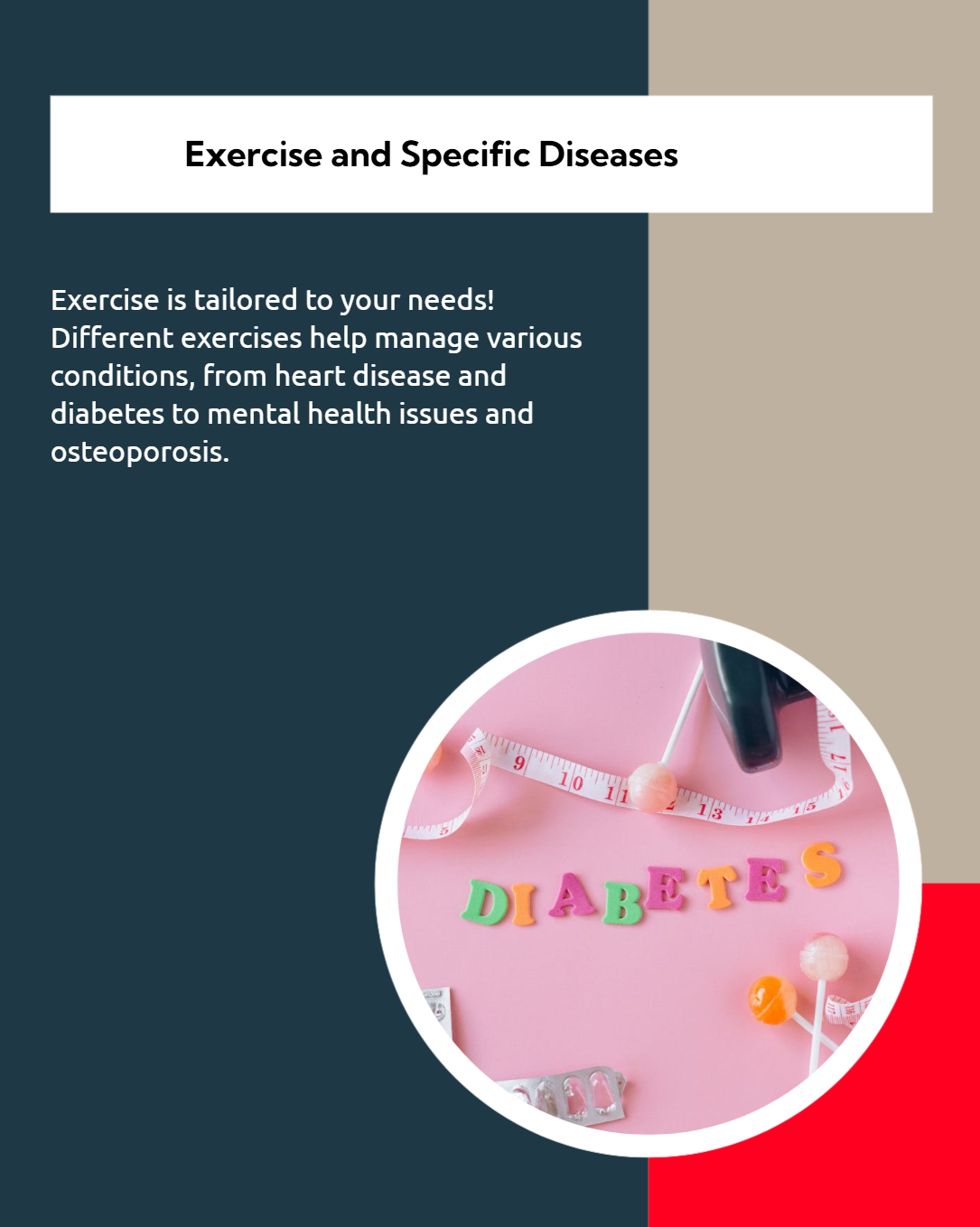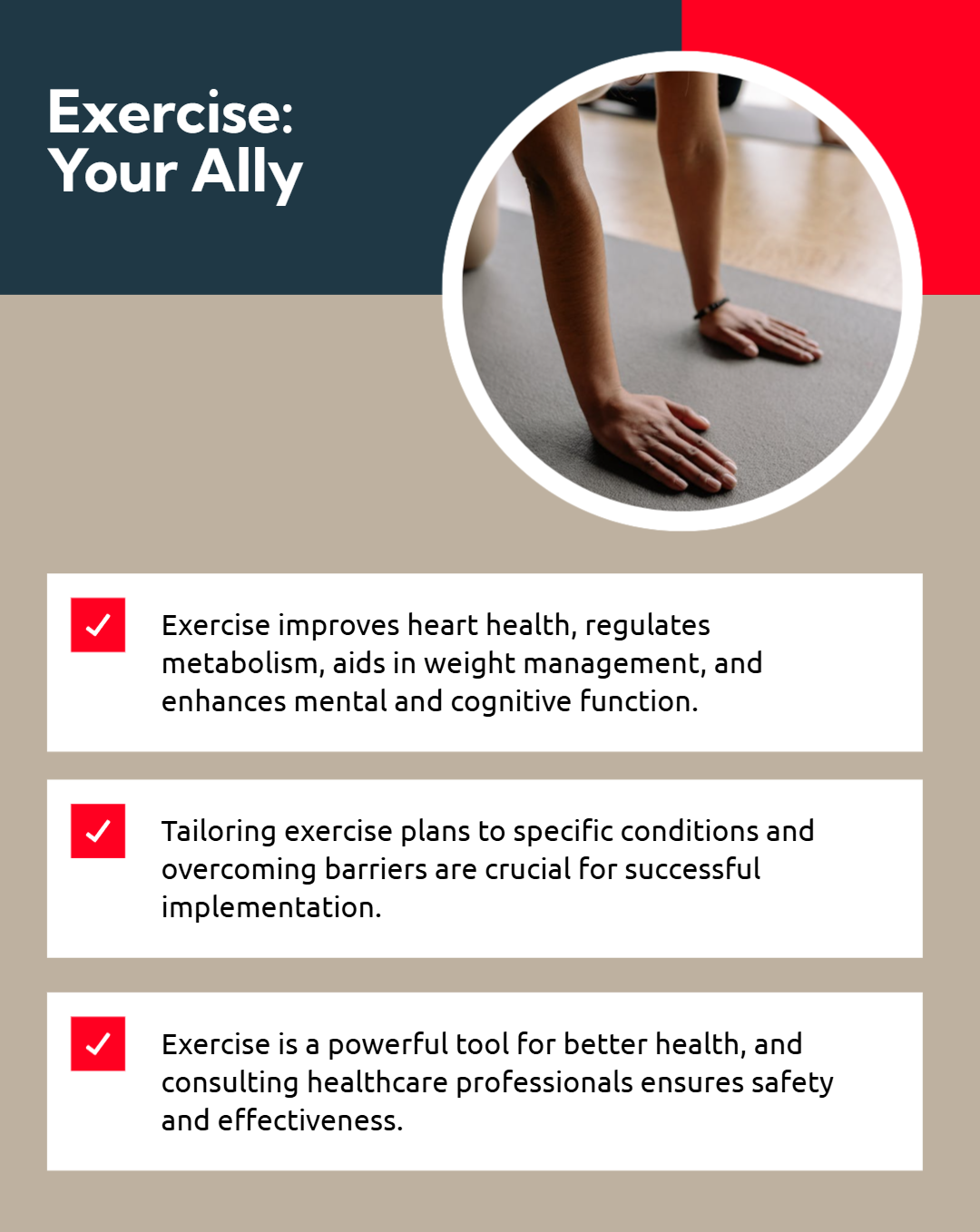PHYSICAL ACTIVITY AS A THERAPEUTIC MODALITY: MECHANISMS BEHIND EXERCISE-INDUCED BENEFITS IN CHRONIC DISEASE MANAGEMENT
HOME
BLOG
PHYSICAL ACTIVITY AS A THERAPEUTIC MODALITY: MECHANISMS BEHIND EXERCISE-INDUCED BENEFITS IN CHRONIC DISEASE MANAGEMENT
Physical activity is more than just a means to stay fit—it is a powerful therapeutic tool for managing chronic diseases. Exercise has been extensively researched for its role in improving health outcomes in conditions such as cardiovascular disease, diabetes, obesity, and mental health disorders. This article explores the mechanisms through which exercise exerts its benefits, the types of exercises most effective for specific conditions, and practical strategies for incorporating physical activity into chronic disease management.

How Exercise Acts as Medicine
Physical activity influences various physiological systems, including the cardiovascular, metabolic, nervous, and immune systems. Its effects go beyond weight management and fitness, directly impacting disease progression and symptom management.
Cardiovascular Benefits
Regular exercise improves heart health by:
- Enhancing circulation: Increased blood flow helps supply oxygen and nutrients to tissues.
- Lowering blood pressure: Exercise promotes vasodilation and reduces arterial stiffness.
- Reducing inflammation: Chronic inflammation is a key factor in heart disease, and exercise lowers inflammatory markers like C-reactive protein (CRP).
Metabolic Regulation
For individuals with diabetes or metabolic syndrome, exercise plays a crucial role by:
- Improving insulin sensitivity: Muscles become more efficient at using glucose, reducing blood sugar levels.
- Regulating lipid metabolism: It lowers LDL (bad cholesterol) and increases HDL (good cholesterol).
- Enhancing mitochondrial function: More efficient energy production leads to reduced oxidative stress.
Weight Management and Obesity Control
Exercise aids in weight loss and maintenance by:
- Boosting metabolism: Strength training increases muscle mass, which burns more calories at rest.
- Reducing visceral fat: Physical activity helps target harmful abdominal fat associated with metabolic diseases.
- Regulating appetite hormones: It balances ghrelin and leptin, reducing cravings and overeating.
Mental Health and Cognitive Function
The benefits of exercise extend to psychological well-being by:
- Increasing endorphins and serotonin: These chemicals improve mood and reduce anxiety.
- Enhancing neuroplasticity: Exercise stimulates brain-derived neurotrophic factor (BDNF), essential for learning and memory.
- Reducing stress hormones: Cortisol levels drop, helping to manage stress and depression.
Immune System Boost
Regular exercise strengthens immune function by:
- Enhancing circulation of white blood cells: This helps detect and fight infections more efficiently.
- Reducing chronic inflammation: Exercise modulates inflammatory cytokines, which contribute to various chronic conditions.
- Improving gut microbiome health: A balanced microbiota strengthens immunity and lowers disease risk.

Exercise and Specific Chronic Diseases
1. Cardiovascular Disease (CVD)
Recommended Exercises:
- Aerobic activities (walking, cycling, swimming) improve heart efficiency.
- Strength training (moderate intensity) enhances vascular function.
- Yoga and stretching improve heart rate variability and stress management.
Key Mechanisms:
- Enhances endothelial function and arterial flexibility.
- Reduces hypertension and atherosclerosis progression.
- Improves cardiac output and oxygen utilization.
2. Type 2 Diabetes
Recommended Exercises:
- Resistance training improves glucose uptake by muscles.
- High-intensity interval training (HIIT) rapidly lowers blood sugar.
- Low-impact activities like yoga improve insulin function.
Key Mechanisms:
- Boosts GLUT-4 transporters for better glucose absorption.
- Improves pancreatic beta-cell function.
- Reduces systemic inflammation and oxidative stress.
3. Obesity and Metabolic Syndrome
Recommended Exercises:
- A combination of strength and aerobic training for fat loss.
- Core and functional training improve mobility and metabolic rate.
- HIIT burns high amounts of calories in short sessions.
Key Mechanisms:
- Modulates adipokines, reducing leptin resistance.
- Prevents fat accumulation and promotes lean muscle mass.
- Enhances post-exercise oxygen consumption (EPOC) for extended calorie burn.
4. Depression and Anxiety
Recommended Exercises:
- Mind-body activities (Tai Chi, yoga) reduce stress and enhance relaxation.
- Cardiovascular exercises increase serotonin and dopamine.
- Strength training builds resilience and self-efficacy.
Key Mechanisms:
- Decreases cortisol and inflammatory cytokines.
- Boosts hippocampal growth, reducing depression symptoms.
- Enhances neurotransmitter function and neural connectivity.
5. Osteoporosis and Arthritis
Recommended Exercises:
- Weight-bearing exercises (walking, jogging) strengthen bones.
- Strength training increases bone density and joint support.
- Flexibility exercises (stretching, yoga) reduce stiffness and pain.
Key Mechanisms:
- Stimulates osteoblast activity for stronger bones.
- Increases joint lubrication and mobility.
- Reduces inflammatory markers associated with arthritis pain.

Practical Strategies for Incorporating Exercise
Personalizing Exercise Plans
Each individual’s needs vary based on their condition, fitness level, and lifestyle. Creating a customized exercise routine ensures adherence and effectiveness.
Tips:
- Start with low-intensity activities and gradually progress.
- Incorporate exercises that are enjoyable to sustain long-term commitment.
- Mix aerobic, strength, and flexibility exercises for balanced benefits.
Overcoming Barriers to Exercise
Many people with chronic diseases struggle with motivation or physical limitations.
Solutions:
- Lack of time: Break workouts into shorter sessions (10-15 minutes).
- Pain or discomfort: Choose low-impact activities like swimming or cycling.
- Fatigue: Opt for gentle movement exercises like yoga or Tai Chi.
- Lack of motivation: Find a workout partner or use fitness tracking apps.
Professional Guidance and Support
Consulting healthcare professionals ensures safety and effectiveness in exercise routines.
Recommendations:
- Work with a physical therapist or certified trainer for personalized guidance.
- Engage in supervised exercise programs if dealing with severe conditions.
- Join a community or online support groups for motivation and accountability.

Key Takeaways
Physical activity is a powerful and accessible therapeutic tool for managing chronic diseases. By understanding the mechanisms behind exercise-induced benefits, individuals can make informed choices about their health. Whether preventing or managing conditions like cardiovascular disease, diabetes, or mental health disorders, regular exercise improves quality of life and longevity. The key is consistency, personalization, and finding joy in movement.
FAQs
- How much exercise is recommended for chronic disease management?
The World Health Organization (WHO) recommends at least 150–300 minutes of moderate-intensity or 75–150 minutes of vigorous-intensity aerobic exercise per week, combined with strength training twice a week.
- Can exercise replace medication for chronic diseases?
Exercise can significantly reduce reliance on medication, but should be used as a complementary therapy rather than a complete replacement. Always consult a doctor before adjusting medications.
- Is high-intensity exercise safe for individuals with chronic diseases?
It depends on the condition and individual fitness level. Supervised high-intensity training can be safe and beneficial for some, but others may need to stick to moderate-intensity activities.
- What are the best exercises for people with limited mobility?
Seated exercises, resistance band workouts, water aerobics, and chair yoga are excellent options for maintaining strength and flexibility while minimizing strain.
- How long does it take to see the benefits of exercise in chronic disease management?
Some benefits, like improved blood sugar levels and reduced stress, appear immediately, while others, such as weight loss or increased bone density, may take weeks or months of consistent effort.
 17.02.2025
17.02.2025




 17.02.2025
17.02.2025